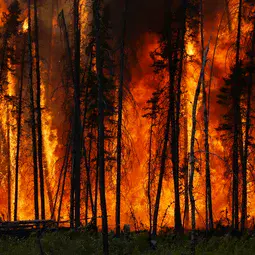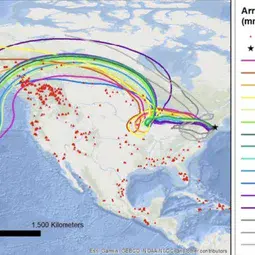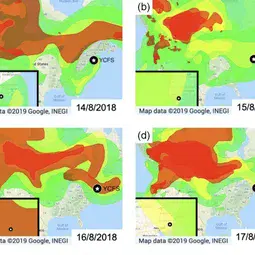Air pollution in New York City linked to wildfires hundreds of miles away
21 January 2020
A new study shows that air pollutants from the smoke of fires from as far as Canada and the southeastern U.S. traveled hundreds of miles and several days to reach Connecticut and New York City, where it caused significant increases in pollution concentrations.
For the study, published 21 January in the European Geosciences Union (EGU) journal Atmospheric Chemistry and Physics, researchers in the lab of Drew Gentner, associate professor of chemical & environmental engineering, monitored the air quality at the Yale Coastal Field Station in Guilford, CT and four other sites in the New York metropolitan area. In August of 2018, they observed two spikes in the presence of air pollutants – both coinciding with New York-area air quality advisories for ozone. The pollutants were the kind found in the smoke of wildfires and controlled agricultural burning. Using three types of evidence – data from the observation sites, smoke maps from satellite imagery, and backtracking 3-D models of air parcels (both the maps and models were produced by the National Oceanic and Atmospheric Administration) – the researchers traced the pollutants’ origin in the first event to fires on the western coast of Canada, and in the second event to the southeastern U.S.
Biomass burning, which occurs on a large scale during wildfires and some controlled burns, is a major source of air pollutants that impact air quality, human health, and climate. These events release numerous gases into the atmosphere and produce particulate matter (PM), including black carbon (BC) and other primary organic aerosols (POA) with a diameter of less than 2.5 micrometers. Known as PM2.5, it has been shown to have particularly serious health effects when inhaled.
While more reactive components are often chemically transformed closer to their place of origin, PM2.5 tends to last longer. In the case of this study, that allowed much of it to travel from the fires to the monitoring sites – a period ranging from a few days to about a week.
“Given the sensitivity of people to the health effects emerging from exposure to PM2.5, this is certainly something that needs to be considered as policy-makers put together long-term air quality management plans,” Gentner said.
The impacts of wildfire smoke will likely become increasingly important in the coming years.
“When people are making predictions about climate change, they’re predicting increases in wildfires, so this sort of pollution is likely going to become more common,” said lead author Haley Rogers, who was an undergraduate student when the study was conducted. “So when people are planning for air pollution and health impacts, you can’t just address local sources.”
Although the levels of the PM2.5 decreased over time and distance, co-author Jenna Ditto, a graduate student in Gentner’s lab, noted that awareness of its presence in the atmosphere is critical to public health.
“Studies indicate that there are no safe levels of PM2.5, so typically any level of it is worth taking a look at,” she said.
###
Please mention the name of the publication (Atmospheric Chemistry and Physics) if reporting on this story and, if reporting online, include a link to the paper (https://doi.org/10.5194/acp-20-671-2020) or to the journal website (https://www.atmospheric-chemistry-and-physics.net/).
More information
This research is presented in the paper “Evidence for impacts on surface-level air quality in the Northeastern U.S. from long-distance transport of smoke from North American fires during LISTOS 2018” published in the EGU open access journal Atmospheric Chemistry and Physics on 21 January 2020.
The study was conducted by Haley M. Rogers, Jenna C. Ditto, and Drew R. Gentner, Department of Chemical and Environmental Engineering, Yale University.
Citation: Rogers, H. M., Ditto, J. C., and Gentner, D. R.: Evidence for impacts on surface-level air quality in the northeastern US from long-distance transport of smoke from North American fires during the Long Island Sound Tropospheric Ozone Study (LISTOS) 2018, Atmos. Chem. Phys., 20, 671–682, https://doi.org/10.5194/acp-20-671-2020, 2020.
The European Geosciences Union (EGU) is the leading organisation for Earth, planetary and space science research in Europe. With our partner organisations worldwide, we foster fundamental geoscience research, alongside applied research that addresses key societal and environmental challenges. Our vision is to realise a sustainable and just future for humanity and for the planet. We publish a number of diverse scientific journals, which use an innovative open access format, and organise topical meetings, and education and outreach activities. The annual EGU General Assembly is the largest and most prominent European geosciences event, attracting more than 16,000 scientists from all over the world in 2019. The meeting’s sessions cover a wide range of topics, including volcanology, planetary exploration, the Earth’s internal structure and atmosphere, climate, as well as energy and resources. The EGU General Assembly 2020 is taking in Vienna, Austria, from 3 to 8 May. For information and press registration, please check https://www.egu.eu/gamedia closer to the time of the event, or follow the EGU on Twitter and Facebook.
If you wish to receive our press releases via email, please use the Press Release Subscription Form at https://www.egu.eu/news/subscribe/. Subscribed journalists and other members of the media receive EGU press releases under embargo (if applicable) 24-48 hours in advance of public dissemination.
Atmospheric Chemistry and Physics (ACP) is an international scientific journal dedicated to the publication and public discussion of high-quality studies investigating the Earth’s atmosphere and the underlying chemical and physical processes. It covers the altitude range from the land and ocean surface up to the turbopause, including the troposphere, stratosphere, and mesosphere.
Contact
Scientist
Dr. Drew R. Gentner
Associate Professor
Department of Chemical and Environmental Engineering
Yale University
Phone +1 (203) 432-4382
Email drew.gentner@yale.edu
Press officers
Terri Cook
Head of Media, Communications and Outreach
European Geosciences Union
Munich, Germany
Phone +49-89-2050-76340
Email media@egu.eu
EGU on Twitter: @EuroGeosciences
William Weir
Director of News & Outreach
Yale University School of Engineering & Applied Science
Phone +1 203 432 0195
Email william.weir@yale.edu



